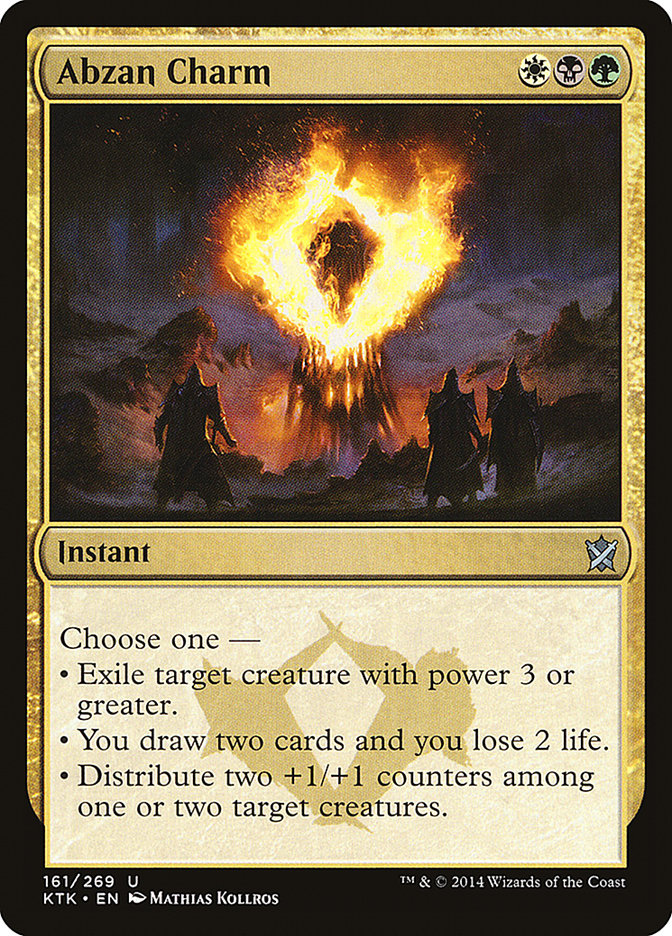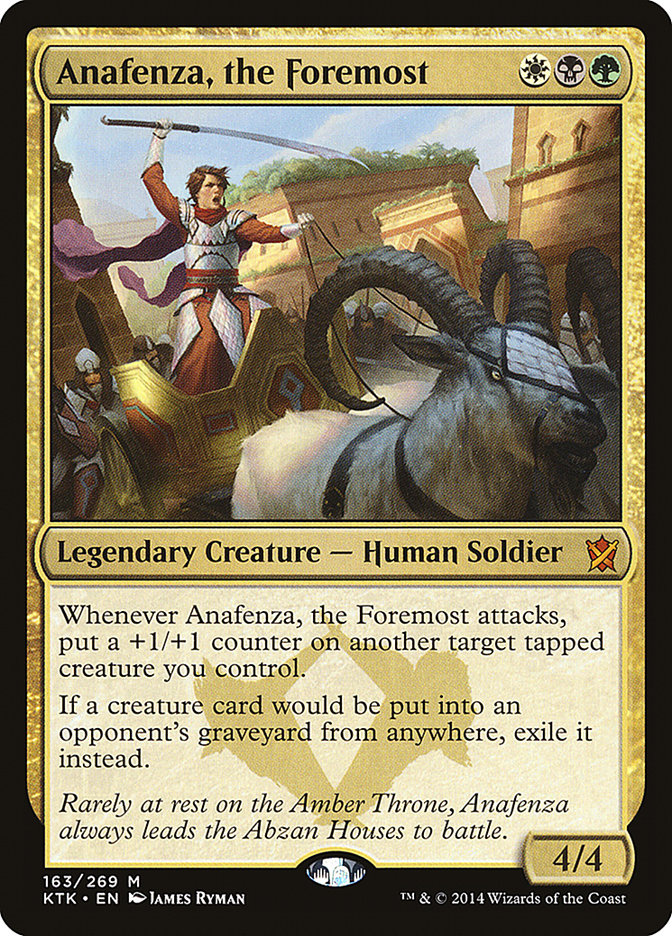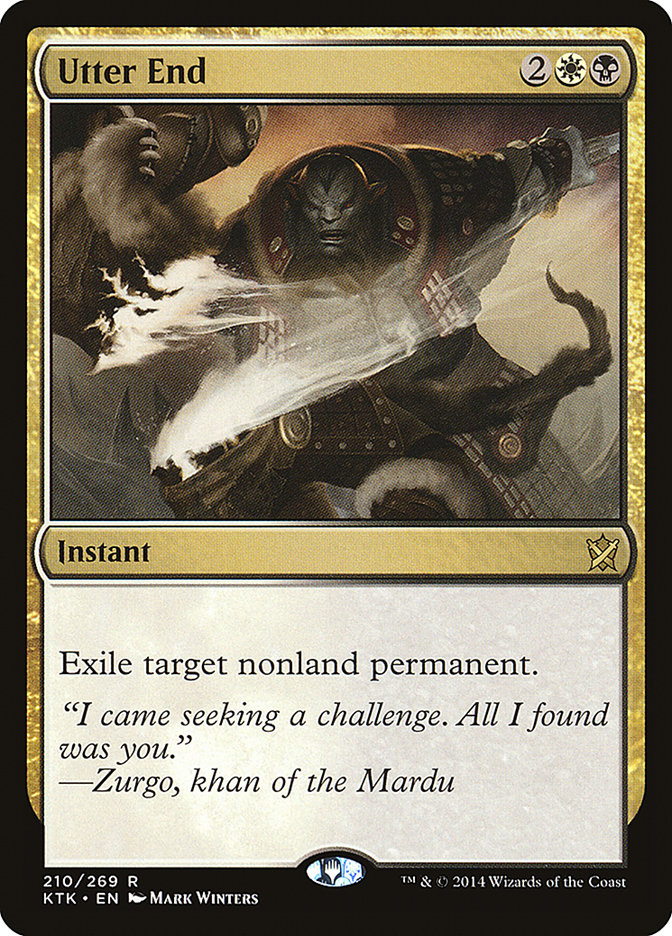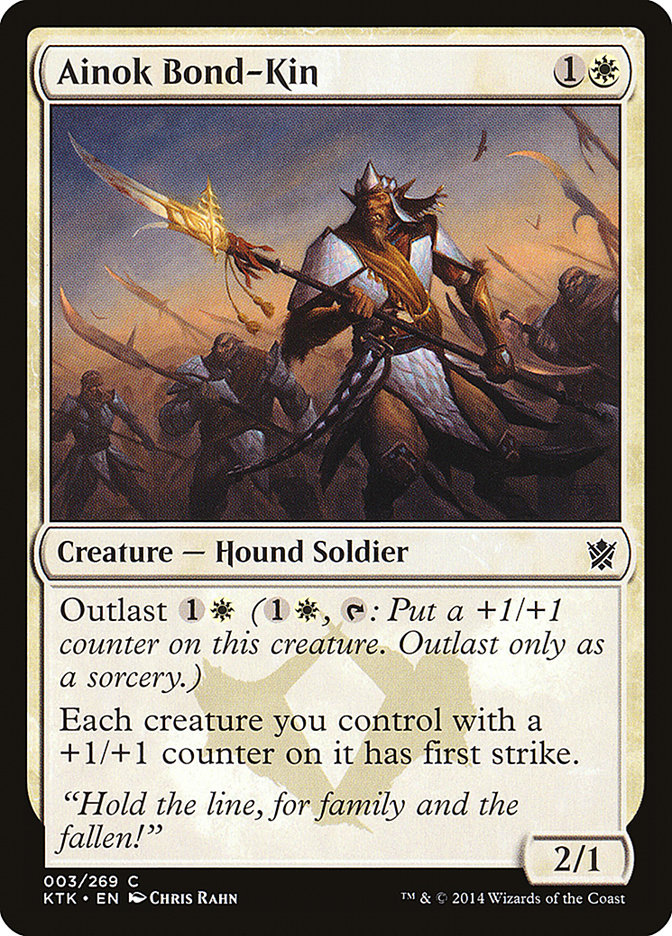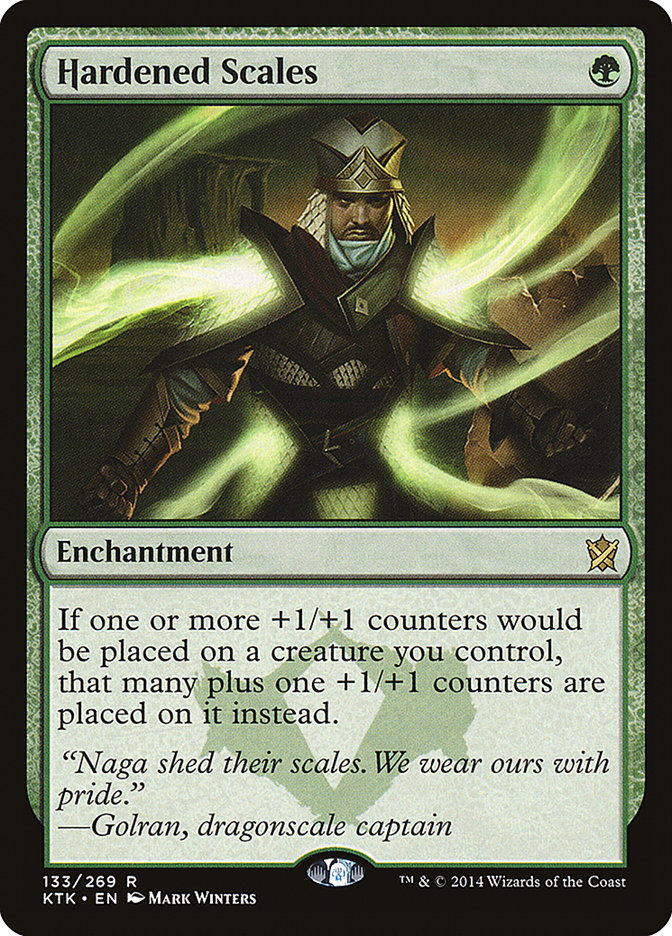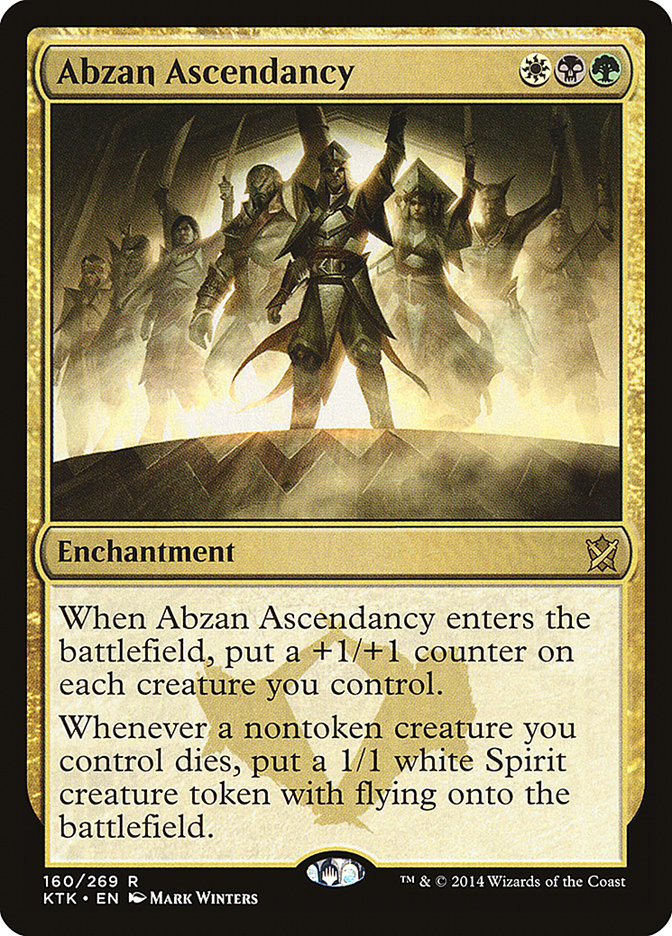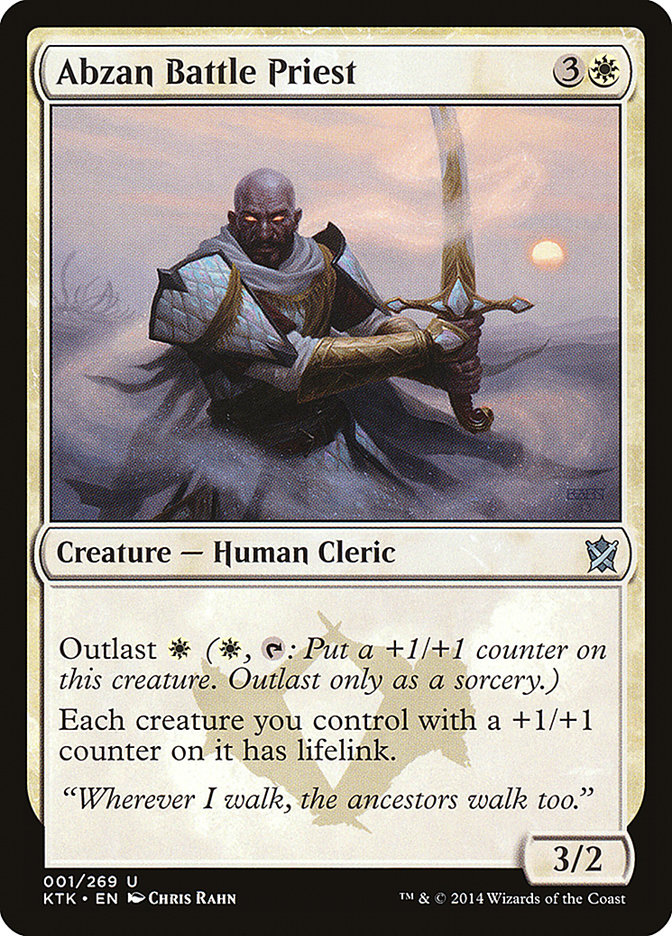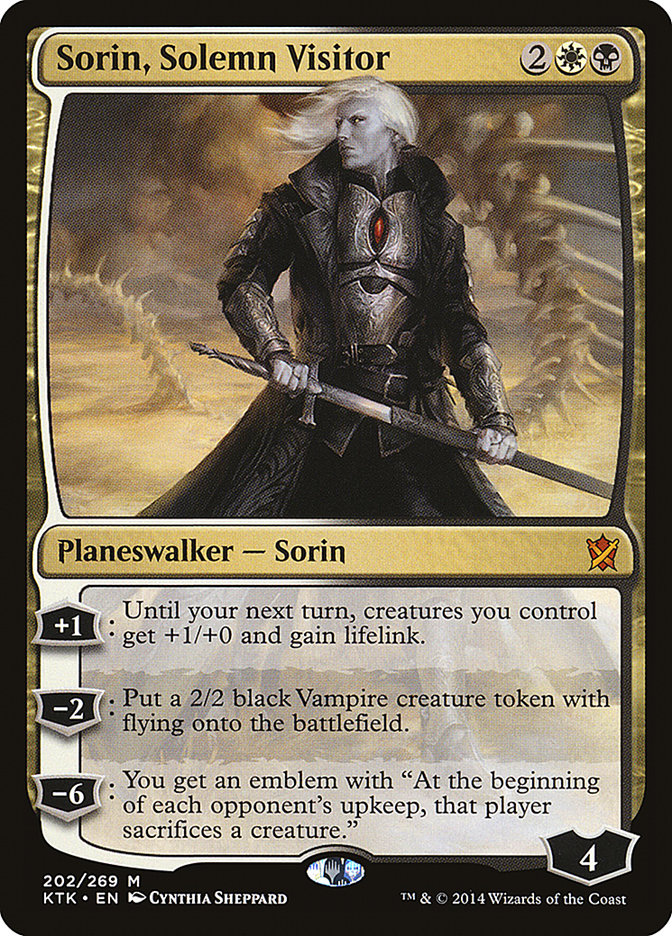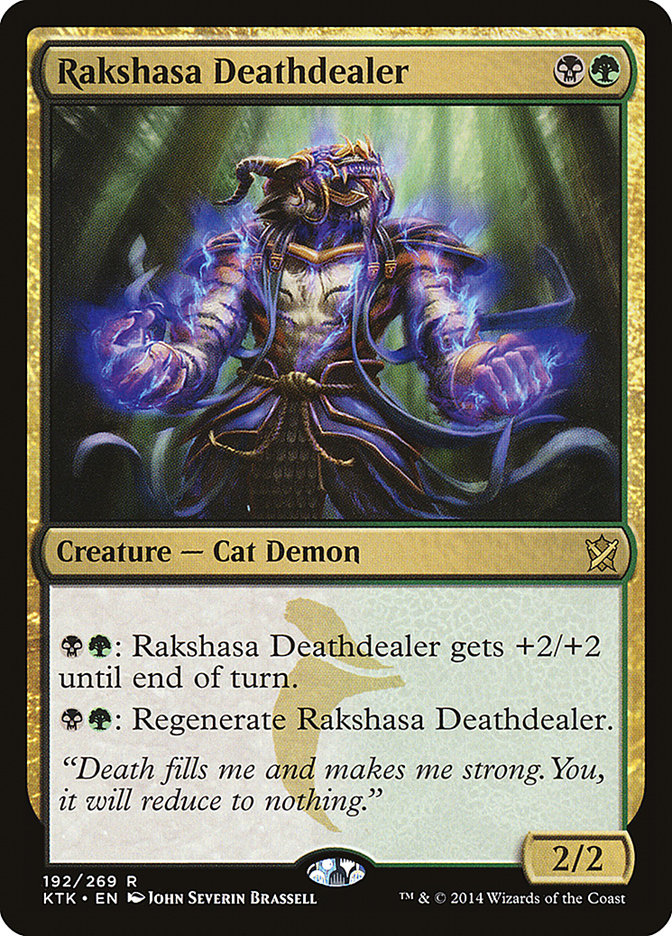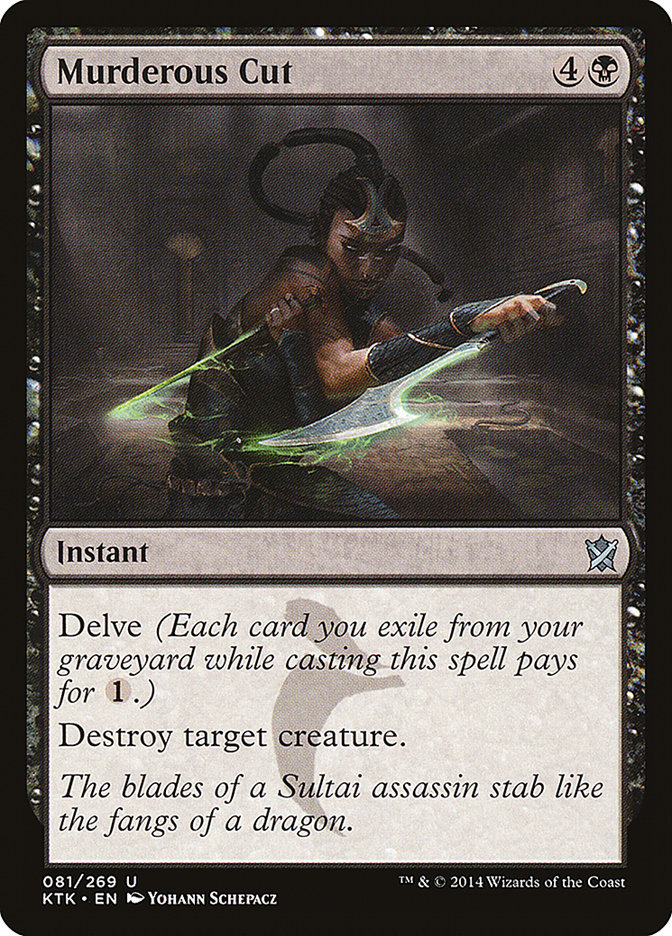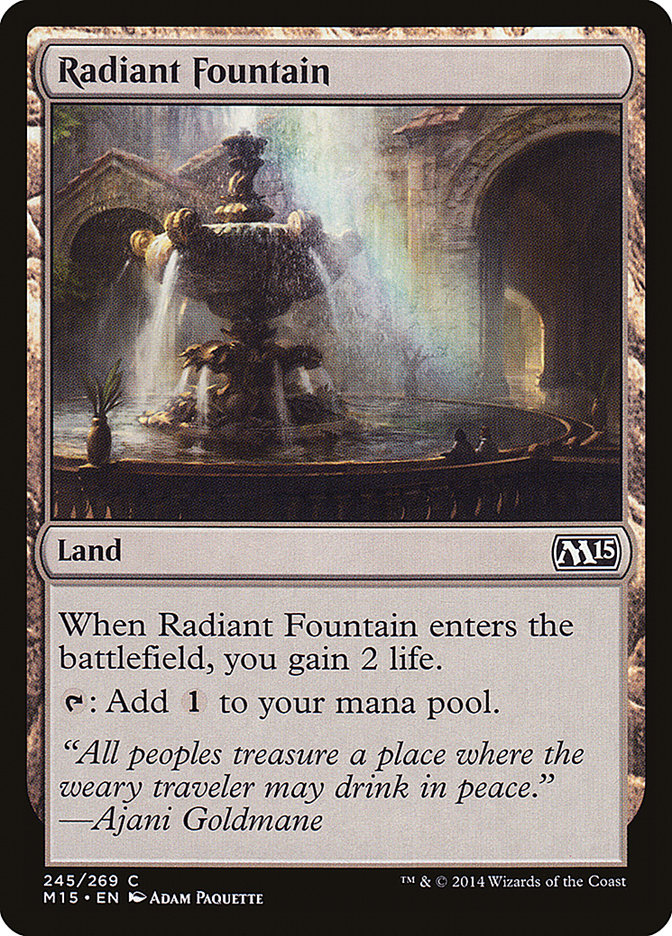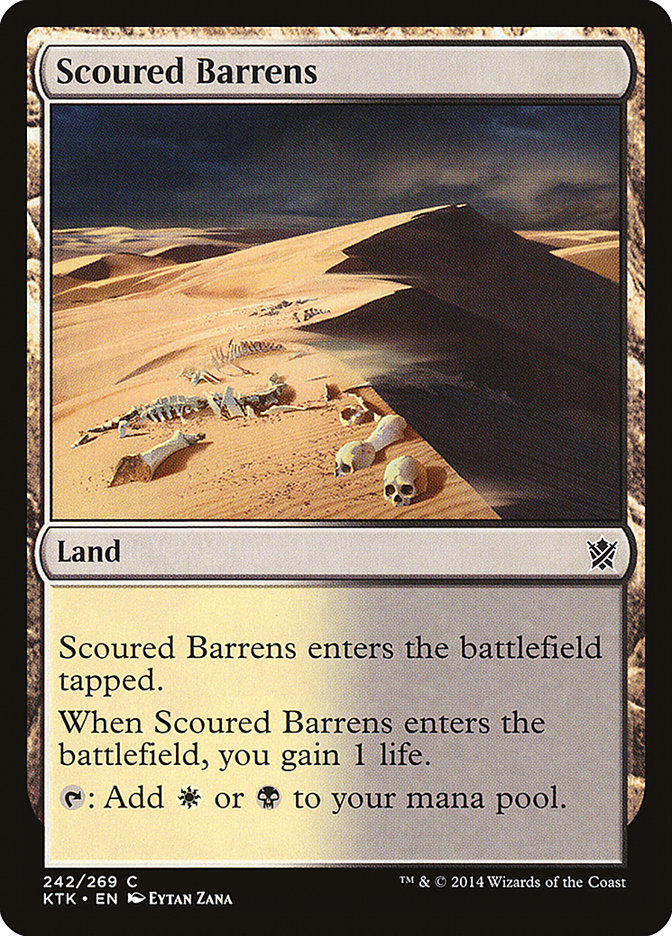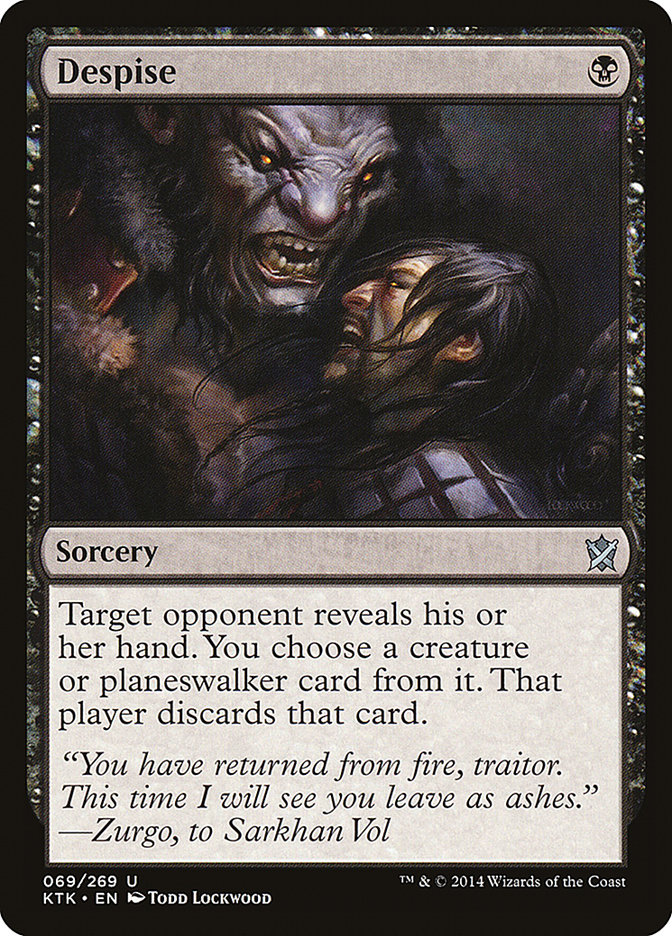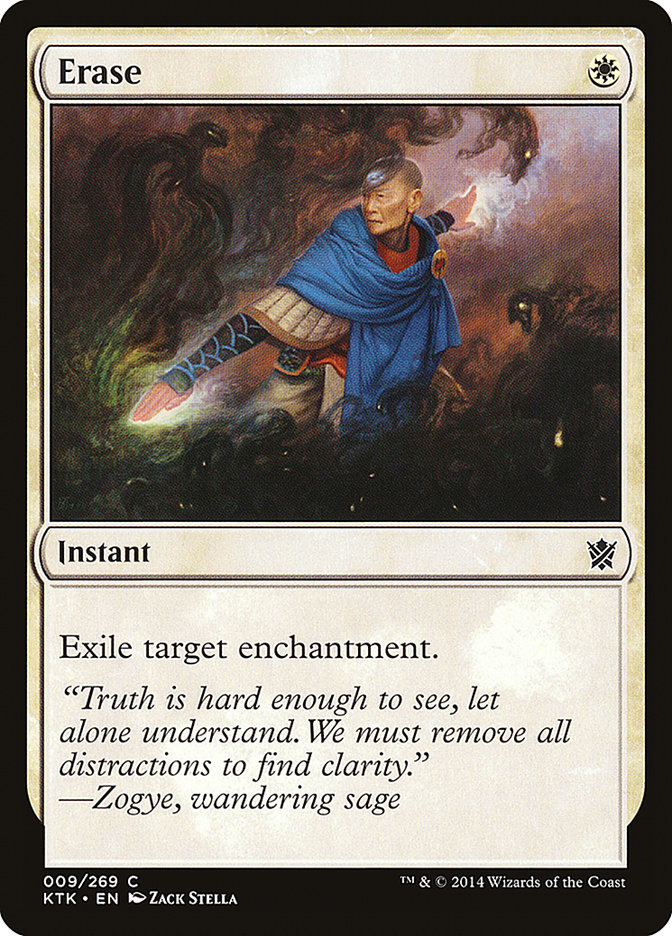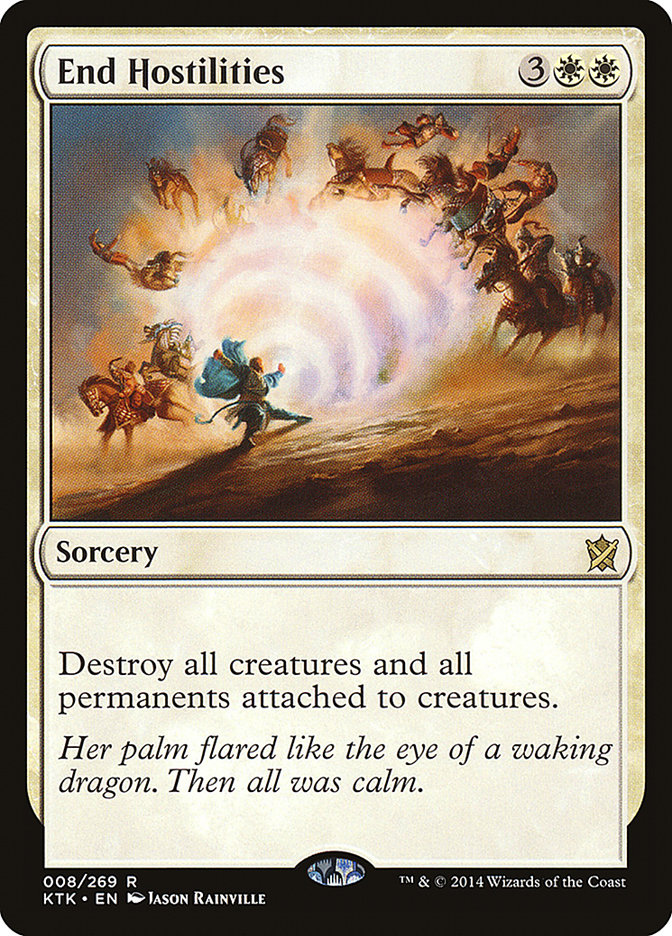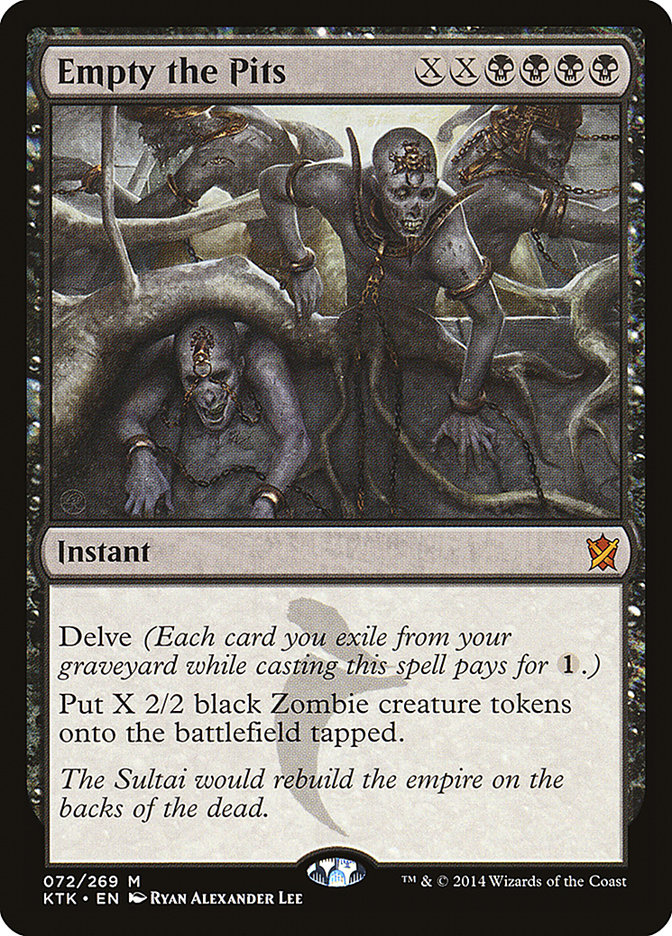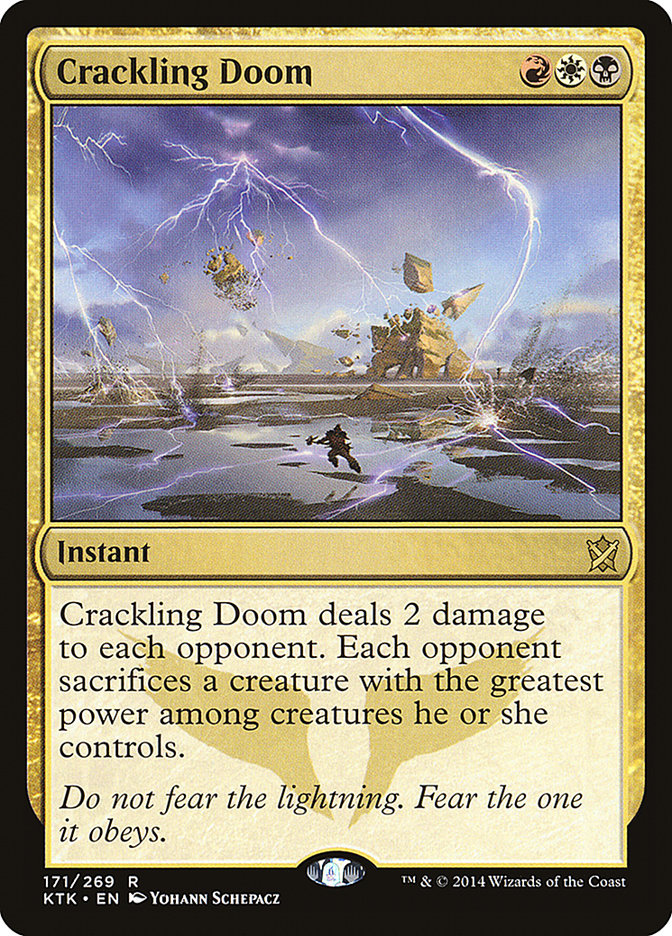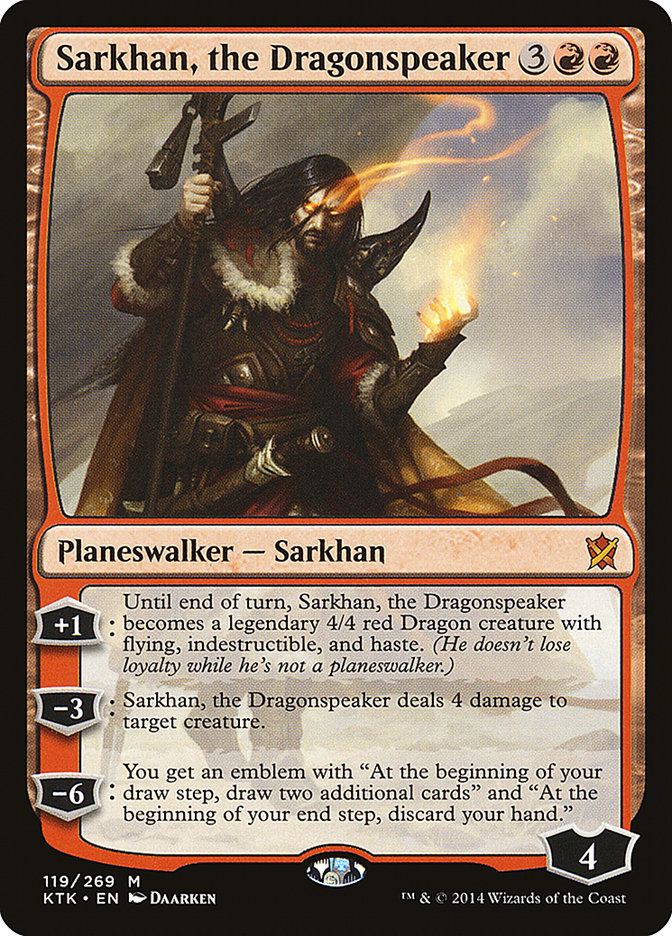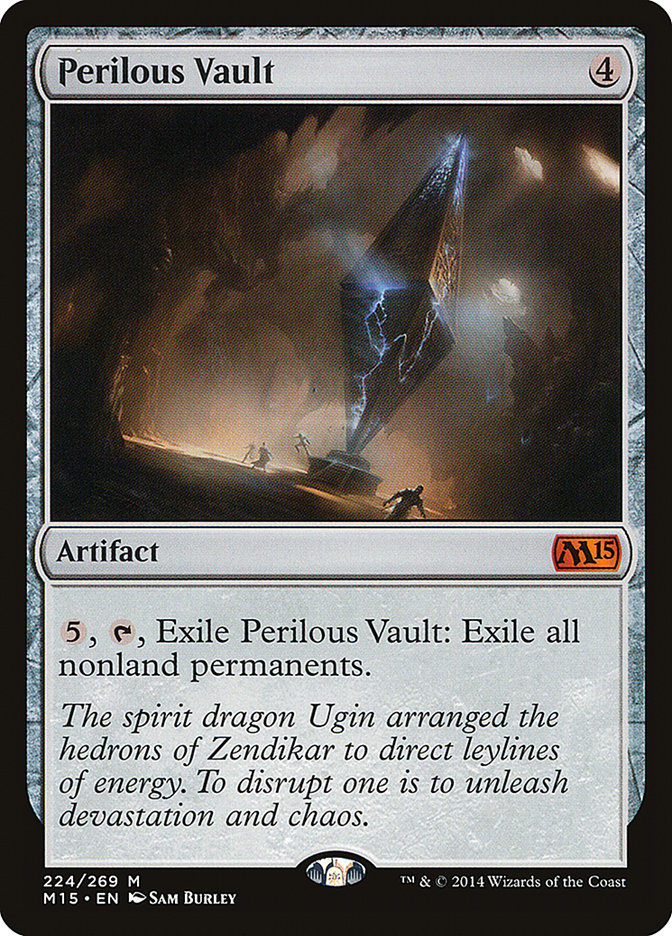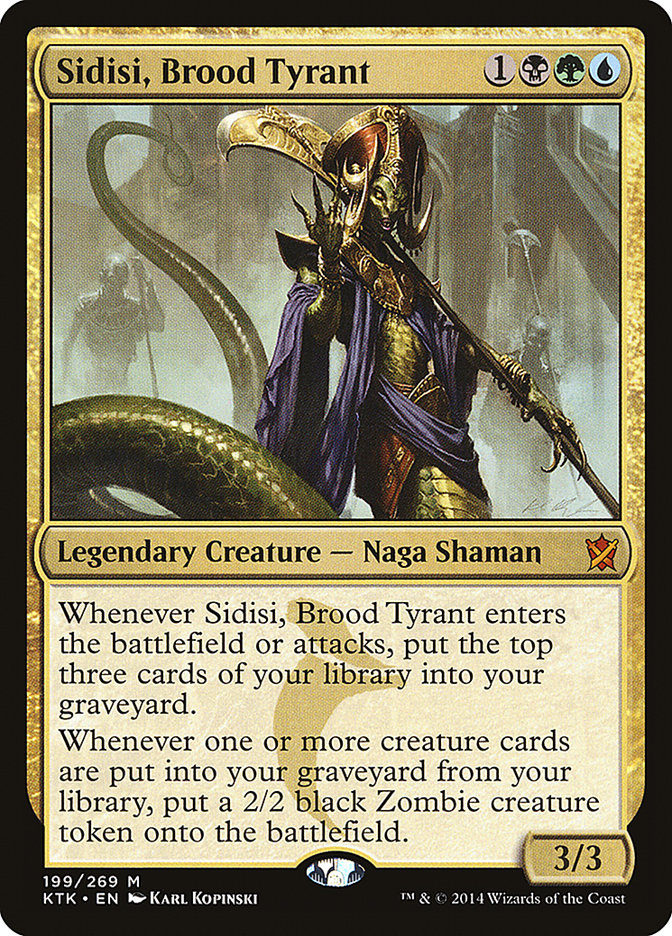One of the most hotly anticipated sets of all-time (Of All-Time) is finally here, and this one is coming pretty freaking hard.
Have you seen this set?!
Look, it’s not even just that Sphinx’s Revelation, Supreme Verdict, Pack Rat, and Lifebane Zombie are gone…
Though they are, and that’s reason to celebrate with dancing in the streets…
It’s that Khans of Tarkir has chances of being a true masterpiece. The feel of the set is very visceral and fun. The mechanics have promise and weave
together to form a beautiful tapestry. It suggests a new world with very different rules than the one we’ve been used to. But no matter how rich and
wonderful the world appears on the surface, the real question is how will the format shake out? Will it hold up to scrutiny?
To understand how the new tools available to us from Khans of Tarkir fit into the format, let’s take a brief look at the legacy of the previous four sets.
At first glance, the format appears to have four pillars:
This isn’t anything unusual. I mean, that is the best card of each of the four real colors. Observant readers may notice a lack of Thoughtseize, which may
prove to be a defining card again, but I kind of feel like this format is looking to be a fair bit like Block but with a much stronger aggro presence.
Thoughtseize was good in Block, but it wasn’t busted or anything like it was six months ago.
Wait a minute. What about Blue…?
Well, let’s just say it isn’t Blue’s month.
Trust me, the color will be fine. It’s not like Blue’s ever going to be behind long enough for the other colors to catch up in the big picture. It’s just
that, at the moment, Blue is a distant fifth place in terms of power. Most of the good blue cards that do exist are gold cards, taking advantage of being a
color that actually gets good cards.
What’s the best mono-blue card in the new set?
Okay, sure. I’ll give you that one. We’re going to get a lot more in depth on Blue later in the week. Today’s focus is on midrange, and I only bring this
up to help paint the picture of the format, which is one with four strong colors and one weak one. Understanding the inherent weakness of Blue helps give
us an idea of what sort of a world we might be stepping into, what sorts of decks we’re looking at facing day one.
Today, I’d like to take a stab at midrange strategies in the format to come. I’ve got a feeling they are likely to be the best, or most of the best
strategies for the next few months. There are a lot of possibilities for aggro, as well as some ways to approach control, and even a few combo decks;
however, if we’re going to succeed with any of those styles, we’ve got to know what we’re up against. When everyone throws their first drafts together, the
midrange decks are going to have an advantage if only on account of just how powerful the best midrange cards are.
Looking at those four pillars, Goblin Rabblemaster is a little bit of an odd duck, as it generally doesn’t just slide into the same sorts of midrange and
control decks that employed the other three (and helped define Block Constructed). The other three all fit nicely into one of the new Khans, and even
benefit from the best Charm, and from an early candidate for best card in the set:
Let’s start with the Siege Rhino, as I think it has a real strong possibility of proving to be the best card in the set, and it’s certainly an easy top
five, no matter which way things shake out. The funny thing is, I’ve seen an awful lot of people only medium on the Siege Rhino.
Eh, yeah, it’s okay. I’m not sure if you even want it over Polukranos or Reaper of the Wilds.
It’s a good card, but it doesn’t really fit into any particular strategy.
Sure, it’s better than Loxodon Hierarch, I guess.
Are you kidding me?
The card is a 4/5 trampler, to start with. If we could buy that for WBG, we’d be all about it. That’s not to say it should cost WBG. Normally, that’d cost
five mana, and we’re already getting a discount. It’s just that if it cost three mana, we’d for sure slam a playset. Beyond that, we’re being charged one
more mana to drain our opponents for three (without spending a card).
Stop a second and think about that.
You get a Woolly Thoctor-esque body, if you agree to also buy a one-mana cantrip drain for three. Hell, I’d pay one mana to gain three life in an awful lot
of spots. Alternatively, paying one mana for haste is sort of like dealing three damage (haste would let us deal four, but could potentially be blocked).
You literally get both, and that’s on top of a card that’s already on sale, mana-wise. Draining your opponent for three has generally more powerful of an
effect on the game than drawing a card, by a good amount.
What about contextually? Sure, the card’s rate is absolutely absurd, but how does it line up in the format?
Well, to start with, it crashes through Courser of Kruphix, and generally outclasses most of the best midrange creatures. It dodges most of the cheap
removal, like Lightning Strike, Bile Blight, and even avoids the best burn spell, Stoke the Flames. It even beats Mardu Charm, Sultai Charm, and Jeskai
Charm! What actually kills it? Hero’s Downfall and the like, but of course, it still drains for three, putting you way ahead (a two-for-one, of sorts, in
terms of value if not raw material).
Siege Rhino is that rare combination of literal tippity-top level rate and well positioned against everything going on. It so obviously fits right into one
of the most obvious and natural strategies of the format. I believe the card will be one of the defining cards of the format and might be the best card in
the set.
As for Abzan Charm, the card is somewhat reminiscent of Azorius Charm in that it has two modes that cover all situations, so it’s basically always good.
Against creatures, Azorius Charm was an important way to buy some time. Against everything else, you would have time to cycle it, so it had little
opportunity cost. Abzan Charm is an even more extreme version of that. Against creatures, it is a powerful removal spell (with its only two weaknesses
being Courser of Kruphix and one-drops). Against everyone else, it is an instant speed draw-two! Yeah, it costs life, but with Siege Rhino on top of
Courser of Kruphix, we’ve got life to spare.
Abzan Charm’s third mode is actually great too, even if it will get used less often. The power of modal spell options is linked to how good they are when
you use them. Having a niche option that wins you a lot of games when you play it is worth a lot, even if you don’t do it that often, as long as the
options you do all the time are good. Abzan Charm already has two modes that cover most game states, so a niche option is a perfect fit. Giving two +1/+1
counters at instant speed makes all of your attacks more threatening for your opponent. Brimaz, in particular, is going to bounce off of defenders a fair
bit, but a single Abzan Charm completely changes the texture of the game.
Abzan Charm works especially well with Siege Rhino, as the extra counters let the Rhino trample through for extra damage. This can be particularly useful
for when you have two Rhinos and are just trying to sneak in the final points of damage, or when players block to save a planeswalker with exactly one
loyalty left. It takes a full twelve points of toughness to stop two Rhinos from damaging a player if they have an Abzan Charm in hand.
Remember, you can also combine Abzan Charm with Elspeth to hit more creatures. For instance, you can end step pump their Brimaz and their Lion if you want
to drop Elspeth and wipe them both out.
Wait, you can pump your opponent’s creatures with Abzan Charm?
You Abzanlutely can! You can also respond to your opponent’s Elspeth activation with a surprise pump to kill their own side of the board.
Normally, I’d snap off four Abzan Charms in every Abzan deck without even a thought, but between Courser of Kruphix, Brimaz, King of Oreskos, Anafenza, the
Foremost, Hero’s Downfall, Banishing Light, and Read the Bones, there are far more amazing threes than we can possibly play, so the bar has to go up for
what it takes to be good enough. Still, I’d like to start with four copies, and see if we can get away with it.
Here’s an Abzan Midrange deck, obviously descended from the Block deck:
Creatures (19)
Planeswalkers (5)
Lands (24)
Spells (12)

This format has a fairly decent number of one-drops and tons of amazing three-drops, but is actually kind of sparse at the two-spot. Figuring out how to
capitalize on that is one of the more important puzzles facing us, and this list attempts to answer that question the same way it was answered in Block.
Fleecemane Lion gets outclassed more in this format than it did in Block, however, the threat of Abzan Charm turning it into a 5/5 to beat opposing Siege
Rhinos or Courser of Kruphix with value is a nice added bonus.
Why not Anafenza, the Foremost? It’s very possible that it’s just right to play her, but she’s better when you have more creatures that cost less than her
that are planning on attacking a lot. Brimaz kind of plays into the whole “nine removal spell” plan. Brimaz does get outclassed a lot more than he did in
Block, and it is pretty brutal that Abzan Charm kills him (whereas a traditional Reprisal effect would not).
Siege Rhino as a four-of over Polukranos or Reaper of the Wilds? I would play ten Siege Rhinos, if I could. That card is stupidly good. Play more fours if
you want, but I would definitely make the first four Rhinos.
No Silence the Believers? Abzan Charm really reduces the need for Silence the Believers, giving you up to eight removal spells before having to even spend
four mana. Additionally, Silence the Believers really suffers from how much faster the new format is (so many good one-drops), and with how much more
diverse the threats you face are (such as Chandra, Sorin, and Nissa). Finally, some of the value of Silence the Believers comes in how well it crushes
bestow. The new format looks to have less bestow than Block by far, and the new wrath, End Hostilities, punishes bestow so hard there is even less
incentive for people to play it.
The Block deck did play nine removal spells though, and I think we’ve got room for one more here. Banishing Light is fine, but we are so glutted on threes,
Utter End is just better for our purposes. It’s an instant, and they don’t end up getting out of it later. Compared to Silence the Believers, it’s kind of
nice to have the added dimension of being able to surprise take out a Perilous Vault or a Banishing Light.
Another possible direction to go with Abzan is down the outlast path, trying to exploit the new mechanic in an almost tribal fashion. While Outlast, on the
surface, is about making your creatures bigger, I think the real mechanic is “+1/+1 counters matter,” and we can play a number of the +1/+1 counter
“lords,” which plays right into Fleecemane Lion, Anafenza, Abzan Charm, Ajani, Mentor of Heroes.
Here’s a first draft of Abzan Outlast:
Creatures (23)
- 4 Elvish Mystic
- 4 Fleecemane Lion
- 2 Ainok Bond-Kin
- 3 Anafenza, the Foremost
- 4 Siege Rhino
- 4 High Sentinels of Arashin
- 2 Abzan Falconer
Planeswalkers (2)
Lands (24)
Spells (11)

The idea is to play sort of a mid-speed aggressive strategy that happens to put +1/+1 counters all over the place. Then, sometimes all of our creatures
have first strike or flying for free. Additionally, the +1/+1 counters make High Sentinels of Arashin into 5/6 or 6/7 fliers for four. Hardened Scales also
makes the +1/+1 counter theme go nuts. Use Ajani’s +1/+1 counter ability on three different creatures and you’ll get six counters, and Abzan Ascendancy
goes nuts, +2/+2ing your entire team. Plus, if your opponent plays End Hostilities, you’ll still have a team of fliers. Drop another Ascendancy the turn
after with a Scales in play, and you’re attacking for twelve the turn after they swept away four creatures!
This list has too many four-drops, but Siege Rhino is too good not to play, and the High Sentinels are a great reward for all the +1/+1 counter action. I
actually think High Sentinels could turn out to be a little bit of a sleeper and will show up in some non-outlast decks just on account of being a 3/4
flier that produces good value turn after turn. Just think about how hard it is to attack or block when your opponent has a High Sentinel! I can’t even
imagine playing against that card in Draft. In short, underrated. Keep an eye on this one. It dies to tons of removal, but so did Desecration Demon.
I was going to play one Abzan Battle Priest because of just how awesome it would be to give our team lifelink with how big our creatures get. The thing is,
Sorin, Solemn Visitor just does it better. Even still, we probably just have too many four-drops and might as well just play another Ajani, Mentor of
Heroes. Once you have so many four-cost cards that you are likely to draw two, it is like the second one costs a mana more (assuming you hit your land
drops).
How good is Sorin? Pretty solid. I think he’s going to show up in small numbers in creature heavy decks where he’ll be good, not great. I think putting him
in creature-light decks like Esper isn’t going to work out well enough. Too much of the power of the card is tied up in the +1/+0 and lifelink part of the
card, not the token-making.
Despite how attractive getting a dance with the Rhino is, there is also a lot of appeal to experimenting with shaving a color all the way off. After all,
if we can get a lot of the power with just two-colors, we’re going to have a lot more untapped lands and come out the gates hard.
What if we cut white?
Creatures (23)
- 4 Elvish Mystic
- 3 Polukranos, World Eater
- 4 Sylvan Caryatid
- 3 Reaper of the Wilds
- 4 Courser of Kruphix
- 1 Reclamation Sage
- 4 Rakshasa Deathdealer
Lands (23)
Spells (14)

Rakshasa Deathdealer is more of an aggressive card than control, but at least it has added utility late. It’s not just that it pumps like crazy. The
regeneration ability is actually likely to overperform, as creature slug-fests and overcosted Doom Blades are all the rage. It’s no Fleecemane Lion, but it
could still be good enough. Heir of the Wilds is another alternative that is better at defending early while still packing something of a punch later. I’d
much rather start with the Deathdealer though, as it is a much stronger Magic card on rate.
While Reaper of the Wilds and Polukranos, World Eater can’t really fill Siege Rhino’s shoes, they are pretty good. Polukranos, in particular, was a bit
weak in Block but is poised to make a comeback. It’s pretty good against the weenies, and it’s good against fliers, which generally seem well positioned.
This build goes with a lower mana curve, kind of trying to stay more aggressive, but it might still want some bigger cards, like Nissa, Worldwaker. She is
much worse than she used to be though, because of Sarkhan, the Dragonspeaker. Stormbreath Dragon was already good enough against her, but now Sarkhan
greatly increases the number of times she is going to be attacked for four outright. She also lost a lot of utility because of the loss of Overgrown Tomb
and the like. I think that if you want to be playing Nissa now, it is likely because of wanting to ramp into super expensive cards like Genesis Hydra,
Hornet Queen, and Chord of Calling.
Murderous Cut is an interesting one. On rate, it’s great. It’s efficient and meshes really well with fetchlands. The first couple you put in your deck are
mostly free, and you usually end up with a one-cost removal spell that you can’t play on the first three turns. That’s still great though, as it lets you
play two cards in one turn and have both be very high impact. Drawing two, however, makes the second one a bit more expensive, so it is likely to be
popular as a two-of (though will sometimes still show up as a four-of, particularly in self-mill decks).
The only catch is that it is living alongside Hero’s Downfall, Silence the Believers, Abzan Charm, and Utter End. That is an incredible amount of awesome
black removal. Each has its place though, and finding the right balance is going to be a challenge that is likely going to be different week to week.
Murderous Cut is less robust than the other options, but the ability to kill any creature for one-mana is a potentially game-changing tempo play.
Another possibility is to instead cut green. After all, black removal + Elspeth was one of the best strategies last month, and it was almost a thing in
block. Could Khans of Tarkir have enough support to push it into the top tier? One thing that’s immediately obvious is that cutting green basically cuts
all of the creatures…
Planeswalkers (6)
Lands (26)
Spells (29)

Yeah, 61 cards, but lots of my first draft playtest decks are. The most common reason I play 61 the first run through with a prototype are when I am not
sure if the deck should have 25 mana or 26 (or 26 vs 27). Besides, early in testing, we’re just trying to get some experience with different cards. That
also encourages us to play more one-ofs than we otherwise would (though one-ofs are just sweet anyway…).
If this were Block, I would have snapped off a playset of Lion Kings, but there are just so many incidental answers to him nowadays. The last thing I want
to do is walk face first into a Crackling Doom! Maybe we end up needing it, but I’d like to try without it in the main, since the aggro decks all have so
many answers they didn’t have in Block, like Stoke the Flames, possibly even Mardu Charm.
One of the advantages to playing two-colors in this format is how much life you gain as payment. If you’re aggressive, you generally take far less damage
from your lands (with four painlands instead of twelve). If you’re more midrange or control, you can play eight lands to gain life off of. Radiant Fountain
isn’t exactly Mutavault, but it’s quite good. In slower decks, I really want to be playing four, and am willing to play Nomad Outpost as virtual Orzhov
Guildgate in order to get the colors I need and still support the full four Radiant Fountains. Evolving Wilds is also an option, and if I had Murderous Cut
maindeck, I’d probably use it instead of the Outpost. Either way, getting to play eight lifegain lands is awesome for any slow strategy, and black decks
particularly benefit from them, as it gives you more fuel for Thoughtseize, Sign in Blood, and Read the Bones.
Despise is an interesting one because I’m not really sure yet who doesn’t have good targets. I want to get more experience with the card, but I could see
it turning out to overperform. It’s just funny, because Duress is the kind of card you want more of against people it hits, while Despise hits about
everyone, but isn’t particularly amazing versus anyone (except R/G Monsters. It is pretty great there).
Playing one or two copies of Erase maindeck is likely to be a popular move, as basically everyone has targets for it to hit, and it is so mana efficient.
It is funny though, trying to choose between it and Revoke Existence. While Deicide has been the obvious choice, there are likely to be less gods than
before. The prospect of saving a mana is very appealing, particularly when we are playing cards like Sign in Blood.
Still, if Perilous Vault or Obelisk of Urd catch on, I could see wanting Revoke Existence instead, or perhaps one Revoke Existence, one Erase. I generally
love the existence of so many tiny options that take you down different paths. It gives me a lot of hope for this format being a dynamic one that evolves
from week to week.
End Hostilities is a natural fit, particularly when we look at this deck like an Esper Control deck. Instead of Divination we have Read the Bones. Instead
of Dissolve, we have Thoughtseize. All that really leaves is Prognostic Sphinx; and maybe Liliana Vess does enough, maybe Empty the Pits means we don’t
need it.
Empty the Pits, in particular, is kind of exciting to me on account of how it meshes with the format. There are a number of sweepers, but most of them are
sorcery speed with Aetherspout being the main exception. The card is slower than things slow enough to be cliches about slowness. However, it does have a
couple things going for it:
1. It’s an instant speed threat that can kill out of nowhere in one giant hit, while being spread across many bodies.
2. It has potent tactical implications, functioning as a ground sweeper, of sorts, or a possible answer to planeswalkers.
You obviously can’t play very many, and in fact, I’d rather play exactly one, we just don’t have any other reliable roads to victory built in. You’re going
to see a number of decks later in the week using Empty the Pits as a one-of in control; however, access to Prognostic Sphinx, Pearl Lake Ancient, and
Ashiok all make me want no more than one Empty.
What if we were playing some self-mill cards in some kind of a Sultai control deck? Might we want more Empty the Pits, then? Unlikely, because why aren’t
we just Digging Through Time harder?
One possible way to get enough victory conditions is to just full-on embrace Mardu, giving us access to Chandra, Pyromaster and Sarkhan, the Dragonspeaker.
Planeswalkers (11)
Lands (26)
Spells (23)

With blue cards so weak right now, there is a lot of incentive to look to other color combinations to build control decks out of.
● Read the Bones is such a good card draw spell and is no longer competing with Sphinx’s Revelation or Jace, Architect of Thought.
● End Hostilities, unlike Supreme Verdict, doesn’t require blue.
● Utter End replaces Detention Sphere, not to mention Hero’s Downfall already doing a lot of that.
● Thoughtseize isn’t the same as Dissolve, but it’s a pretty good card. Hero’s Downfall and Utter End do a lot of Dissolve’s job too.
I absolutely love Crackling Doom, and I think it’s probably the best Mardu card in the set. It doesn’t really fit into control though, being a pretty pure
beatdown card. Even if we just had a few creatures to bash with, we might get enough out of it; but this deck is really going to play out like a control
deck that doesn’t get enough out of it.
Meanwhile, Mardu Charm is kind of overrated. Dealing four to a creature is solid, to be sure, but you’re never really going to get that much ahead on mana,
since it’s not killing anything that costs four or more. It’s kind of like Sultai Charm, as a removal spell, which is to say fine, but nowhere near Abzan
Charm.
The most exciting mode, to me, is the ability to make two 1/1s that have first strike for a turn. This is actually a pretty effective “sweeper” against
one-drops, and is basically game-over, if they attack into it. Even if they don’t have small creatures to sweep or medium-sized creatures to burn, you can
still use Mardu Charm as extra bodies to start doing damage with over time, or to chump with to protect your walkers.
Finally, the Duress mode of Mardu Charm is exceptionally well positioned, even if it is not particularly strong. Yes, paying three for a Duress is not
exactly breathtaking, but you’re only going to do it in the matchups where it’s good, and the fact that it is an instant means you can do it during their
draw step, ensuring they don’t draw Elspeth on a relevant turn. Mardu Charm is a bunch of appealing stuff, but not that good of a rate at any of it. The
abilities are well spread out though, so it’s still fine.
Why Magma Jet instead of Lightning Strike? Fleecemane Lion aside, it’s been looking more and more like the early aggro threats are going to have two
toughness or less. I’d rather have Magma Spray, but Magma Jet is nowhere near as bad against decks with no small creatures.
This guy’s great! In many ways, it’s like a Stormbreath Dragon, but it fits into a controlling or midrange gameplan much better, thanks to its Flametongue
Kavu mode. It also gets hit by a different swath of creature-kill spells than Stormbreath Dragon, dodging Sultai Charm, Murderous Cut, Stoke the Flames,
and End Hostilities.
How good is Sarkhan, the Dragonspeaker? Again, great! The card is excellent, one of the best cards in the set. It’s not quite Elspeth level of power, but
the card is going to play an important role in shaping the format to come. It just has so much raw power, as it is a hasty, difficult to remove threat that
hits hard; it’s a potent two-for-one, and it puts a ton of pressure on people since it threatens to go ultimate so fast (with an ultimate that is a little
underrated).
Alternatively, we could go a different direction to find a kill card, cutting another color instead of adding one. What if we tried to make black devotion
work again?
Creatures (14)
- 4 Gray Merchant of Asphodel
- 1 Erebos, God of the Dead
- 2 Disciple of Phenax
- 2 Squelching Leeches
- 1 Soul of Innistrad
- 4 Disowned Ancestor
Lands (26)
Spells (20)

Man, they sure don’t make black creatures like they used to…
Okay, so maybe we don’t have Pack Rat, Lifebane Zombie, Nightveil Specter, and Desecration Demon, but that doesn’t mean we can’t still take advantage of
Gray Merchant. Disciple of Phenax is the worst Lifebane Zombie ever, and we have too many fours, but at least he’s on plan. Squelching Leeches does kind of
a poor Desecration Demon impression, but at least his heart is in the right place.
The one shining light among the black creatures here (besides Gray Merchant, which is just a great card) is Disowned Ancestor. This one is a risky pick,
since this type of card has not historically tended to be good; but I have a feeling about this one. Power level-wise, the card is nothing special, but
it’s not actually bad either. A 0/4 blocker is going to stop a lot of early attacks, and charge it up just once, now you’re looking at a 1/5 that is hard
to kill and threatens to eat attackers like Soldier of the Pantheon or Firedrinker Satyr.
The thing that makes me really excited about Disowned Ancestor is how legit of an early defender it is, while also being a real threat against slow decks.
If left unchecked, it eventually turns into a threat that has to be dealt with, so even though it’s not “good” against them, it is much, much better than a
card like Magma Spray, for instance. It also tends to sit on the table providing an extra source of devotion, which we really need, given our lack of
Underworld Connections.
Perilous Vault is actually the only reason I’d consider playing something like this. The card really benefits from the rotation, and is sure to be a
fixture in control decks without white (which has End Hostilities); though it will show up in some white decks too. It is a little slow, but it really does
a great job of cleaning up every difficult problem you might be facing. It also makes Thoughtseize a lot better, as it forces people to slowplay their
hand, ensuring your discard spells still work later.
Radiant Fountain in a Squelching Leeches deck? I’d rather cut the Leeches than the Fountain, to be honest. Radiant Fountain is exactly what this deck
needs, and it is basically free beyond the Leeches. So many of the best black cards need life, and this is the most efficient way to get more of it.
While I think that black is a pretty integral part of most midrange strategies at the moment, it’s probably worth at least taking a look at what it might
look like to cut it. For instance, what does that Abzan deck look like without black?
Creatures (25)
- 4 Elvish Mystic
- 4 Polukranos, World Eater
- 4 Sylvan Caryatid
- 4 Fleecemane Lion
- 4 Brimaz, King of Oreskos
- 4 Courser of Kruphix
- 1 Soul of Theros
Planeswalkers (7)
Lands (24)
Spells (4)

The good news is that we’re not short on playables. The bad news is that this list contains literally zero Khans of Tarkir cards beyond Windswept Heath.
The odds that it’s magically good enough, despite not being good before is very low.
Even when I look for other possibilities, most of them are not from Khans of Tarkir. For instance, Sunblade Elite could be good, but is not super well set
up for how big this list goes. Boon Satyr could be okay, but isn’t at its best here. If we’re trying to find a Khans of Tarkir card to put in here, maybe
Wingmate Roc could work. It’s a pretty respectable body and we’re usually going to be able to meet the raid criteria.
Soul of Theros is a card I’m giving a lot of thought to. It’s hard to have the same casting cost as Elspeth, but the card could be good if we can ever
afford that many six-drops. It has an enormous impact on the game if it lives, and even if doesn’t, the Flashback ability is huge.
Overall though, this doesn’t appear to be G/W’s day in the sun. Besides, if we’re going to play this slow and big of a game, why wouldn’t we want Abzan
Charm and Siege Rhino?
One last black deck I’d like to take a look at today is Sultai Self-Mill.
You make blue decks…?
Look, there’s going to be more blue decks later in the week. Slow blue decks often turn into control, whereas today’s focus is on midrange. Besides, the
blue cards suck (cue scene: PT Khans of Tarkir’s top 8 is announced… five blue decks).
There are a lot of potential ways to build self-mill, at the moment. The main questions we need to ask are:
● Sultai, Abzan, or B/G?
● Do we want to keep our graveyard full or empty it? Nighthowler or Dig Through Time?
● Are we enchantment based, or not?
● Reanimator or no?
Here’s a first draft that just tries a few cards:
Creatures (30)
- 4 Elvish Mystic
- 4 Sylvan Caryatid
- 4 Nighthowler
- 4 Courser of Kruphix
- 4 Satyr Wayfinder
- 1 Pharika, God of Affliction
- 4 Nyx Weaver
- 1 Necropolis Fiend
- 4 Sidisi, Brood Tyrant
Lands (22)
Spells (8)

Sidisi is great, a big part of why to play self-mill in the first place. Sidisi basically rules out B/G to me, because I’d want to just splash Sidisi in my
B/G deck, even if I didn’t want any other cards (and in fact, that’s what this list basically is). Sidisi fuels your graveyard synergies while also being a
major threat on its own that needs to be dealt with. Even if they deal with it, you usually have a 2/2 body left over to keep the pressure on.
Necropolis Fiend is a bit more speculative and might just clash too much with Nighthowler. Obviously, the hope is that we can primarily exile non-creature
cards, but regardless, you do end up with a 4/5 flier, which is pretty substantial. That it can pick off enemy creatures is a big increase in utility
compared to Tombstalker (which was a pretty awesome card, itself).
I could see Necropolis Fiend actually turning out to be pretty decent, and if I had my heart set on adding Brimaz to the B/W Midrange deck above, I’d
probably also want to add a Necropolis Fiend or two (cutting Empty the Pits).
Murderous Cut, on the other hand, is just an excellent card. It doesn’t require much delving to make work, so it won’t hurt Nighthowler much, and the tempo
play is exactly what this deck was looking for. It’s very possible that we don’t even want the one Hero’s Downfall, and a fourth cut is totally on the
table.
Sultai Charm is a bit of a speculative addition. It’s much more of a Sultai control card, giving you a versatile removal spell that can also filter cards.
It’s probably too slow for a deck this tempo-based, but I wanted to try one to gain some experience. The better graveyard deck for Sultai Charm is one with
a reanimator package, as it’s a great way to discard Ashen Rider or Hornet Queen early. I will be using more Sultai Charms later in the week when working
on control decks, have no fear…
One of the most obvious midrange strategies for the months to come is G/R/x Monsters. Before, the split was primarily between G/R and G/R/b, but the black
removal doesn’t fit into Jund as easily now. Nowadays, the most obvious alternatives to G/R are Temur and Naya. Let’s start with Temur, since it gains the
most from the new set.
Creatures (29)
- 4 Elvish Mystic
- 4 Polukranos, World Eater
- 4 Sylvan Caryatid
- 2 Stormbreath Dragon
- 4 Courser of Kruphix
- 4 Rattleclaw Mystic
- 2 Sagu Mauler
- 4 Savage Knuckleblade
- 1 Surrak Dragonclaw
Planeswalkers (4)
Lands (23)
Spells (4)

Savage Knuckleblade is awesome, but he does ask some pretty serious things of you. First of all, you have to splash blue, because honestly, if you weren’t
playing the Knuckleblade, why would you even mess up your mana? That said, once you’re on this path, Savage Knuckleblade gives you a lot of tactical
options and a lot of raw power. An in depth breakdown of the Knuckleblade can be found here.
Surrak Dragonclaw is a sweet card, but it is up against some serious competition from Stormbreath Dragon and Sarkhan. Of all its many abilities, it’s
actually the trample ability that most appeals to me (besides flash, which is clearly awesome). Surprising your opponent with trample gives you a lot of
ability to sculpt games in such a way as to blow them out in combat in ways that are rarely seen in Constructed.
Sagu Mauler is actually a pretty appealing part of the Temur package as well. If we were just G/R, we’d play Soul of Shandalar and be fine with it, but
Sagu Mauler is more of what we actually want, giving us a powerful anti-Hero’s Downfall plan. Incidentally, it also makes all of our Rattleclaw Mystics
scarier…
Crater’s Claws is a little bit of much needed early removal, and honestly, I could see playing four. Being able to kill a one-drop on turn 2 is fine, and
later, it becomes a very efficient answer to opposing Sarkhans and Elspeths, as well as giving us a big finisher against people loaded up on removal.
Temur Ascendancy is kind of speculative, but I don’t actually have the highest hopes for it. The extra cards you draw are going to be good against
attrition decks, but that’s not really how you’re trying to beat those people. That it gives haste is great, but it’s really going to come down to if the
format is slow enough that the Temur deck can really be the aggressor. My concern is that it might get stuck on the backfoot too often and not even be able
to take advantage of the haste sometimes.
Alternatively, we could go with the Theros Block style Naya, which Savage Knuckleblade in for Elspeth:
Creatures (19)
- 4 Elvish Mystic
- 3 Polukranos, World Eater
- 4 Sylvan Caryatid
- 2 Stormbreath Dragon
- 4 Courser of Kruphix
- 2 Rattleclaw Mystic
Planeswalkers (11)
- 4 Xenagos, the Reveler
- 4 Elspeth, Sun's Champion
- 1 Ajani, Mentor of Heroes
- 2 Sarkhan, the Dragonspeaker
Lands (24)
Spells (6)

Not too much different here, though it is worth noting how few tapped lands we use here, and if you wanted, you could even replace Temple of Triumph with
Battlefield Forge.
Creatures (25)
- 4 Elvish Mystic
- 4 Polukranos, World Eater
- 4 Sylvan Caryatid
- 3 Stormbreath Dragon
- 4 Courser of Kruphix
- 2 Soul of Shandalar
- 4 Rattleclaw Mystic
Planeswalkers (8)
Lands (23)
Spells (4)

Finally, here’s a stripped down version that focuses instead on consistent and fast mana. It’s not as much raw power, but maybe we don’t need to get so
fancy…
Okay, that’s a lot of decks already, and we’ve only barely scratched the surface. I’ll be back Wednesday (aka, Goblin Rabblemaster Day) with a look at
aggro decks, as well as some single cards to watch. Then, we’ll return on Friday to hit the control decks and the combo decks (and there are some real
combo decks…). Make sure to let me know if there are specific cards or decks you want to see. Even if they more properly belong in midrange, let’s be
serious, there are so many midrange cards in this format, a lot of the aggro and control decks are going to look midrangey, anyway…



